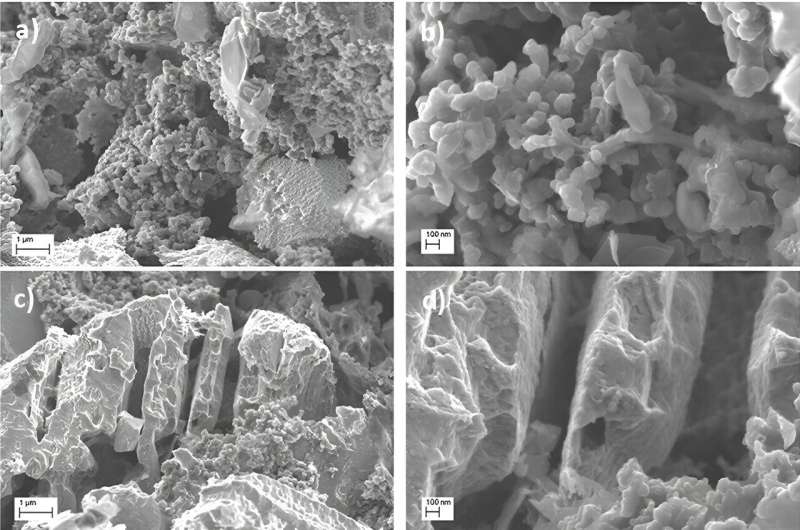The global use of lithium-ion batteries has doubled in just the past four years, generating alarming amounts of battery waste containing many hazardous substances. The need for effective recycling methods for spent lithium-ion batteries is becoming increasingly critical. In the journal ChemElectroChem, scientists from various Polish research institutions have presented a promising solution to this issue.
The research was based on carbon material extracted from electrodes of spent lithium-ion batteries (LIBs). These electrodes underwent an acidic leaching process to recover valuable metals. Depending on the experimental conditions, the resulting carbon material was more or less etched and, after being powdered, still contained trace amounts of metals, including cobalt—which is a metal often used in catalysis. The research aimed to repurpose these battery materials for use in catalytic processes, with a particular focus on those that facilitate the production of hydrogen peroxide.
“Hydrogen peroxide is one of the fundamental chemical molecules, essential to numerous industries. Large-scale production of this substance typically demands high pressures and temperatures, costly catalysts, and various toxic electrolytes. Our focus was on developing a more environmentally friendly method for producing hydrogen peroxide: specifically, an electrochemical approach using catalysts derived from used lithium-ion batteries,” explains Dr. Eng. Magdalena Warczak (PBS), project leader and lead author of the article detailing this accomplishment.
Electrochemical tests revealed that materials recovered from spent LIB batteries, containing carbon nanostructures and cobalt, display catalytic properties in the oxygen reduction reaction. However, it was also found that these properties are highly dependent on the type of sample, specifically its composition and structure, which are largely influenced by the composition of the etching baths used to clean the electrodes extracted from lithium-ion batteries.
“For potential future applications, the crucial finding is that, based on data gathered from experiments using a rotating electrode, we were able to determine the number of electrons involved in the reduction of a single oxygen molecule. The electrochemical reduction of oxygen can occur with either four or two electrons. In the case of four electrons, water is produced, but with two electrons, we obtain the desired hydrogen peroxide. In all the samples we tested, we observed the two-electron reduction,” explains Dr. Warczak.
To eliminate the potential impact of the glassy carbon electrode used as a substrate on the results, the measurements were repeated in systems where individual battery powders were suspended between two immiscible liquids. The organic liquid contained decamethylferrocene, a compound that donates electrons in the oxygen reduction reaction being studied.

Oxygen reduction occurred spontaneously at the interface between the liquids. These studies confirmed that, similar to the experiments with the glassy carbon electrode, all samples catalyzed the oxygen reduction reaction to produce hydrogen peroxide. The concentrations of hydrogen peroxide at the interface, measured using a scanning electrochemical microscope, were one to two orders of magnitude higher than in systems without battery waste.
“Lithium-ion batteries have generally been viewed as just a secondary source of carbon materials, mainly graphite, and metals like lithium, cobalt, or nickel. Meanwhile, our group’s findings clearly demonstrate that battery waste can catalyze the reduction of oxygen to hydrogen peroxide, and in the future, this could lead to its use in producing this important chemical compound,” concludes Dr. Warczak.
Hydrogen peroxide at a 3% concentration is sold in pharmacies as a disinfectant for wounds and inflammation, though its effectiveness for wound care is debatable. Solutions with concentrations of up to 15% are used as bleaches in household cleaning products and cosmetics, such as hair lighteners. A solution with around 30% concentration, known as hydrogen peroxide, is crucial in various industries, including chemical manufacturing (for peroxide synthesis and as an oxidant), pulp and paper and textiles (as a bleach), rubber (as a raw material), electronics and metal (as an etching agent), and food processing (as a biocidal substance).
Interestingly, hydrogen peroxide can also serve as an oxidizer for fuels, including rocket fuels. It first played this role in the 1940s, when it was used in the early rockets capable of crossing the conventional boundary of space. However, at that time, its concentrations did not exceed 80%, and technological limitations hindered the long-term missions.
In contrast, at high concentrations (98% or more), hydrogen peroxide is one of the most environmentally friendly propellants. Just a few weeks ago, it was used in this form for the first time in space flight, powering a suborbital rocket built at the Lukasiewicz Institute of Aviation in Warsaw.
Future research will focus on enhancing the efficiency of electrochemical reactions to a level suitable for future industrial use. Future plans also include exploring four-electron reduction for potential applications in fuel cells.
The team includes researchers from Bydgoszcz University of Science and Technology (PBS), the Institute of Fundamental Technological Research of the Polish Academy of Sciences, the Institute of Physical Chemistry of the PAS in Warsaw, and Wroclaw University of Science and Technology.
More information:
Magdalena Warczak et al, Insights into the High Catalytic Activity of Li‐Ion Battery Waste toward Oxygen Reduction to Hydrogen Peroxide, ChemElectroChem (2024). DOI: 10.1002/celc.202400248
Provided by
Politechnika Bydgoska im Jana i Jedrzeja Sniadeckich
Citation:
Scientists find new use for spent lithium-ion batteries in hydrogen peroxide production (2024, September 18)
retrieved 18 September 2024
from https://techxplore.com/news/2024-09-scientists-spent-lithium-ion-batteries.html
This document is subject to copyright. Apart from any fair dealing for the purpose of private study or research, no
part may be reproduced without the written permission. The content is provided for information purposes only.

